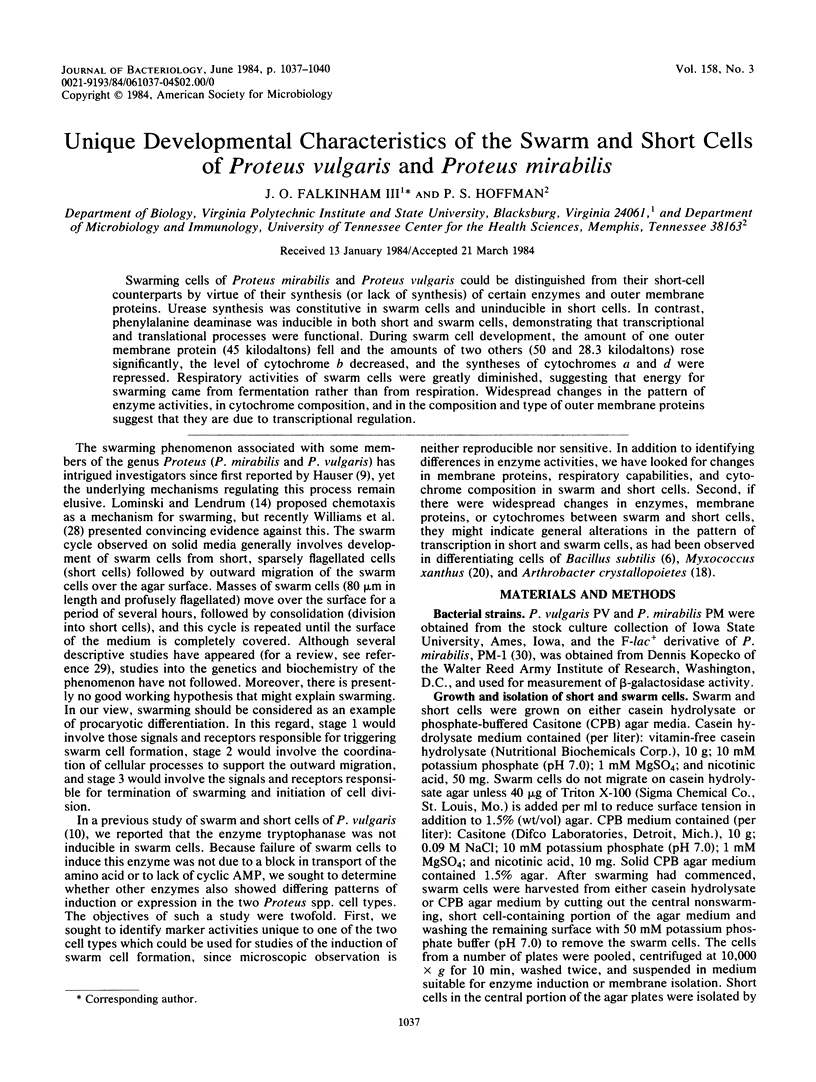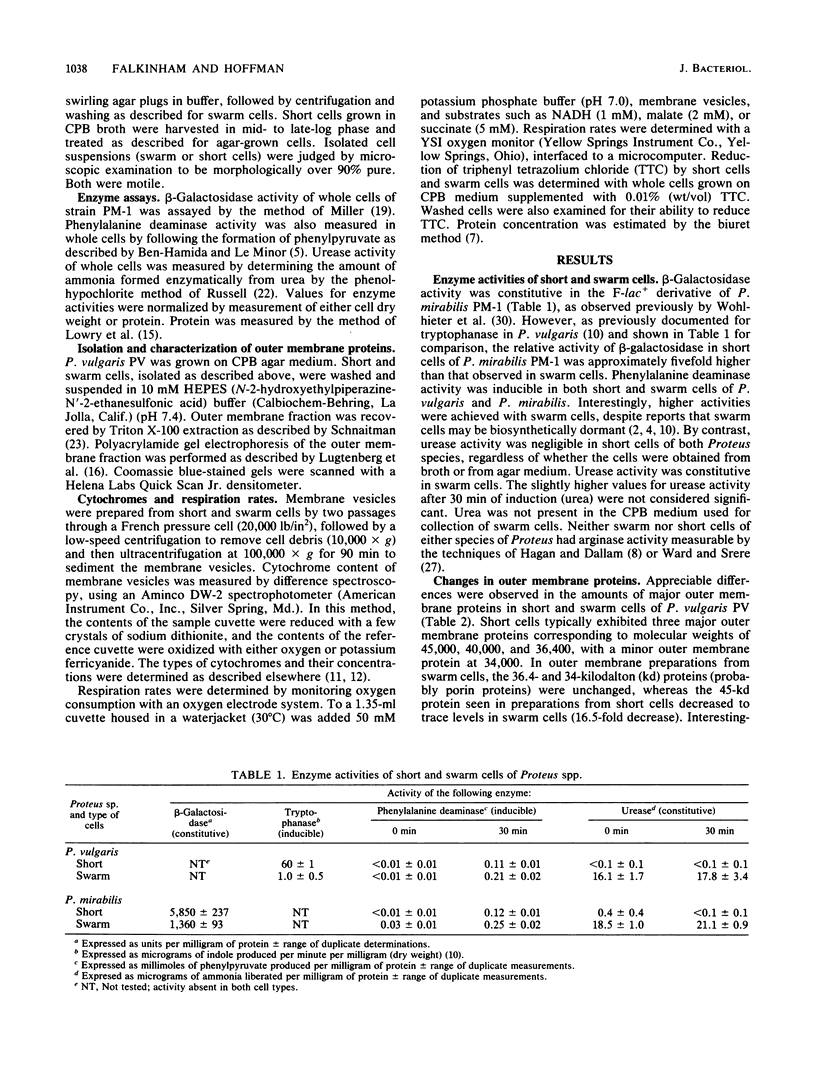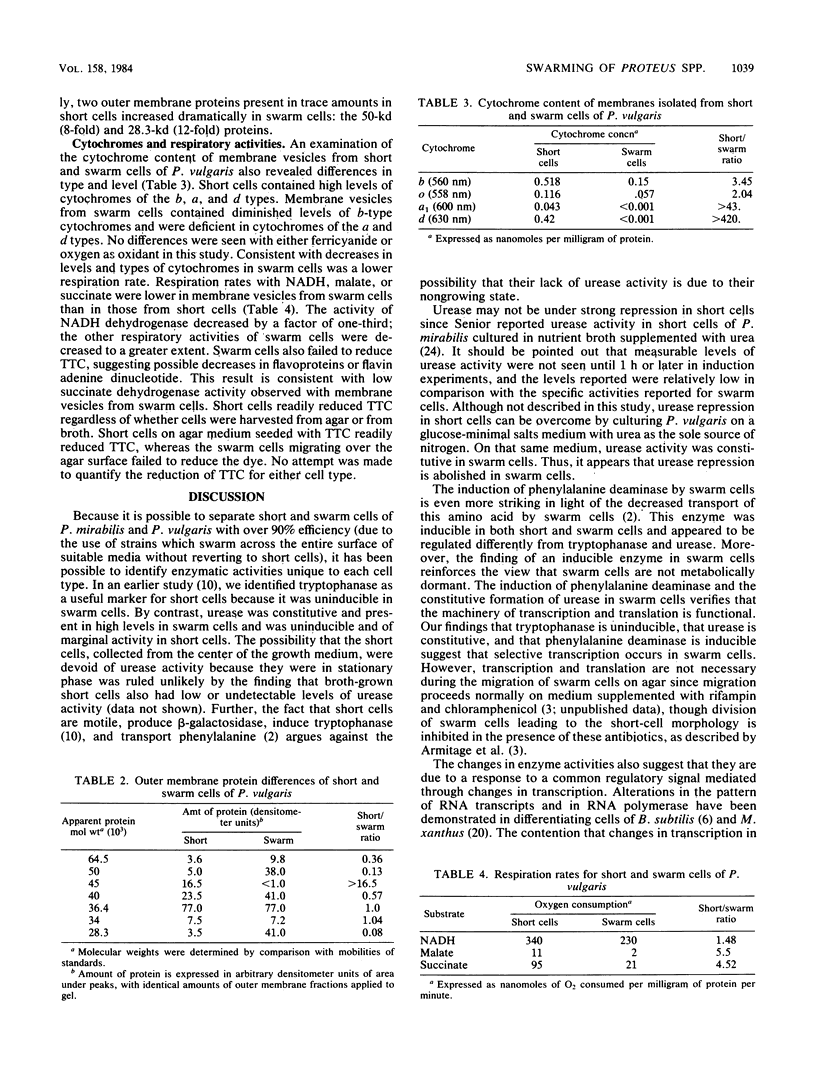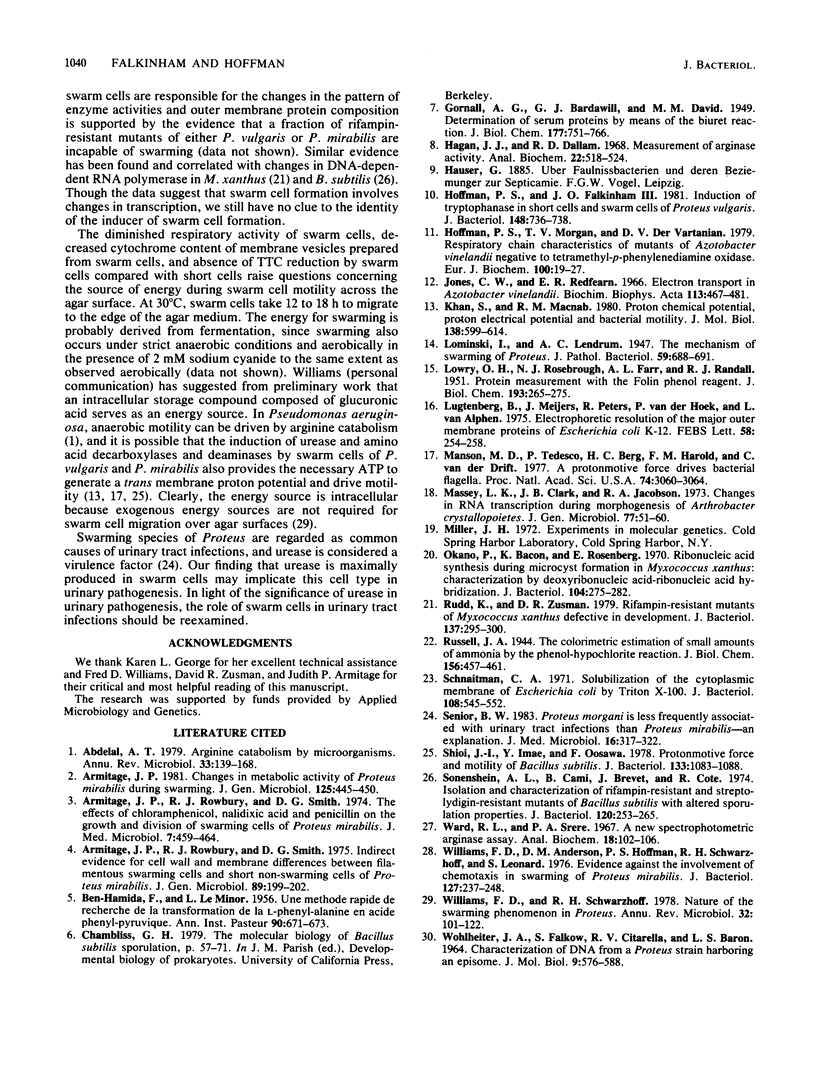Abstract
Swarming cells of Proteus mirabilis and Proteus vulgaris could be distinguished from their short-cell counterparts by virtue of their synthesis (or lack of synthesis) of certain enzymes and outer membrane proteins. Urease synthesis was constitutive in swarm cells and uninducible in short cells. In contrast, phenylalanine deaminase was inducible in both short and swarm cells, demonstrating that transcriptional and translational processes were functional. During swarm cell development, the amount of one outer membrane protein (45 kilodaltons) fell and the amounts of two others (50 and 28.3 kilodaltons) rose significantly, the level of cytochrome b decreased, and the synthesis of cytochromes a and d were repressed. Respiratory activities of swarm cells were greatly diminished, suggesting that energy for swarming came from fermentation rather than from respiration. Widespread changes in the pattern of enzyme activities, in cytochrome composition, and in the composition and type of outer membrane proteins suggest that they are due to transcriptional regulation.
Full text
PDF



Selected References
These references are in PubMed. This may not be the complete list of references from this article.
- Abdelal A. T. Arginine catabolism by microorganisms. Annu Rev Microbiol. 1979;33:139–168. doi: 10.1146/annurev.mi.33.100179.001035. [DOI] [PubMed] [Google Scholar]
- Armitage J. P. Changes in metabolic activity of Proteus mirabilis during swarming. J Gen Microbiol. 1981 Aug;125(2):445–450. doi: 10.1099/00221287-125-2-445. [DOI] [PubMed] [Google Scholar]
- Armitage J. P., Rowbury R. J., Smith D. G. Indirect evidence for cell wall and membrane differences between filamentous swarming cells and short non-swarming cells of Proteus mirabilis. J Gen Microbiol. 1975 Jul;89(1):199–202. doi: 10.1099/00221287-89-1-199. [DOI] [PubMed] [Google Scholar]
- Armitage J. P., Rowbury R. J., Smith D. G. The effects of chloramphenicol, nalidixic acid and penicillin on the growth and division of swarming cells of Proteus mirabilis. J Med Microbiol. 1974 Nov;7(4):459–464. doi: 10.1099/00222615-7-4-459. [DOI] [PubMed] [Google Scholar]
- BEN HAMIDA F., LE MINOR L. Une méthode rapide de recherche de la transformation de la L-phényl-alanine en acide phénylpyruvique. Ann Inst Pasteur (Paris) 1956 May;90(5):671–673. [PubMed] [Google Scholar]
- Hagan J. J., Dallam R. D. Measurement of arginase activity. Anal Biochem. 1968 Mar;22(3):518–524. doi: 10.1016/0003-2697(68)90293-5. [DOI] [PubMed] [Google Scholar]
- Hoffman P. S., Falkinham J. O., 3rd Induction of tryptophanase in short cells and swarm cells of Proteus vulgaris. J Bacteriol. 1981 Nov;148(2):736–738. doi: 10.1128/jb.148.2.736-738.1981. [DOI] [PMC free article] [PubMed] [Google Scholar]
- Hoffman P. S., Morgan T. V., DerVartanian D. V. Respiratory-chain characteristics of mutants of Azotobacter vinelandii negative to tetramethyl-p-phenylenediamine oxidase. Eur J Biochem. 1979 Oct;100(1):19–27. doi: 10.1111/j.1432-1033.1979.tb02029.x. [DOI] [PubMed] [Google Scholar]
- Jones C. W., Redfearn E. R. Electron transport in Azotobacter vinelandii. Biochim Biophys Acta. 1966 Mar 7;113(3):467–481. doi: 10.1016/s0926-6593(66)80005-x. [DOI] [PubMed] [Google Scholar]
- Khan S., Macnab R. M. Proton chemical potential, proton electrical potential and bacterial motility. J Mol Biol. 1980 Apr 15;138(3):599–614. doi: 10.1016/s0022-2836(80)80019-2. [DOI] [PubMed] [Google Scholar]
- LOWRY O. H., ROSEBROUGH N. J., FARR A. L., RANDALL R. J. Protein measurement with the Folin phenol reagent. J Biol Chem. 1951 Nov;193(1):265–275. [PubMed] [Google Scholar]
- Lugtenberg B., Meijers J., Peters R., van der Hoek P., van Alphen L. Electrophoretic resolution of the "major outer membrane protein" of Escherichia coli K12 into four bands. FEBS Lett. 1975 Oct 15;58(1):254–258. doi: 10.1016/0014-5793(75)80272-9. [DOI] [PubMed] [Google Scholar]
- Manson M. D., Tedesco P., Berg H. C., Harold F. M., Van der Drift C. A protonmotive force drives bacterial flagella. Proc Natl Acad Sci U S A. 1977 Jul;74(7):3060–3064. doi: 10.1073/pnas.74.7.3060. [DOI] [PMC free article] [PubMed] [Google Scholar]
- Massey L. K., Clark J. B., Jacobson R. A. Changes in RNA transcription during morphogenesis of Arthrobacter crystallopoietes. J Gen Microbiol. 1973 Jul;77(1):51–60. doi: 10.1099/00221287-77-1-51. [DOI] [PubMed] [Google Scholar]
- Okano P., Bacon K., Rosenberg E. Ribonucleic acid synthesis during microcyst formation in Myxococcus xanthus: characterization by deoxyribonucleic acid-ribonucleic acid hybridization. J Bacteriol. 1970 Oct;104(1):275–282. doi: 10.1128/jb.104.1.275-282.1970. [DOI] [PMC free article] [PubMed] [Google Scholar]
- Rudd K., Zusman D. R. Rifampin-resistant mutants of Myxococcus xanthus defective in development. J Bacteriol. 1979 Jan;137(1):295–300. doi: 10.1128/jb.137.1.295-300.1979. [DOI] [PMC free article] [PubMed] [Google Scholar]
- Schnaitman C. A. Solubilization of the cytoplasmic membrane of Escherichia coli by Triton X-100. J Bacteriol. 1971 Oct;108(1):545–552. doi: 10.1128/jb.108.1.545-552.1971. [DOI] [PMC free article] [PubMed] [Google Scholar]
- Senior B. W. Proteus morgani is less frequently associated with urinary tract infections than Proteus mirabilis--an explanation. J Med Microbiol. 1983 Aug;16(3):317–322. doi: 10.1099/00222615-16-3-317. [DOI] [PubMed] [Google Scholar]
- Shioi J. I., Imae Y., Oosawa F. Protonmotive force and motility of Bacillus subtilis. J Bacteriol. 1978 Mar;133(3):1083–1088. doi: 10.1128/jb.133.3.1083-1088.1978. [DOI] [PMC free article] [PubMed] [Google Scholar]
- Sonenshein A. L., Cami B., Brevet J., Cote R. Isolation and characterization of rifampin-resistant and streptolydigin-resistant mutants of Bacillus subtilis with altered sporulation properties. J Bacteriol. 1974 Oct;120(1):253–265. doi: 10.1128/jb.120.1.253-265.1974. [DOI] [PMC free article] [PubMed] [Google Scholar]
- WOHLHIETER J. A., FALKOW S., CITARELLA R. V., BARON L. S. CHARACTERIZATION OF DNA FROM A PROTEUS STRAIN HARBORING AN EPISOME. J Mol Biol. 1964 Aug;9:576–588. doi: 10.1016/s0022-2836(64)80228-x. [DOI] [PubMed] [Google Scholar]
- Williams F. D., Anderson D. M., Hoffman P. S., Schwarzhoff R. H., Leonard S. Evidence against the involvement of chemotaxis in swarming of Proteus mirabilis. J Bacteriol. 1976 Jul;127(1):237–248. doi: 10.1128/jb.127.1.237-248.1976. [DOI] [PMC free article] [PubMed] [Google Scholar]
- Williams F. D., Schwarzhoff R. H. Nature of the swarming phenomenon in Proteus. Annu Rev Microbiol. 1978;32:101–122. doi: 10.1146/annurev.mi.32.100178.000533. [DOI] [PubMed] [Google Scholar]


